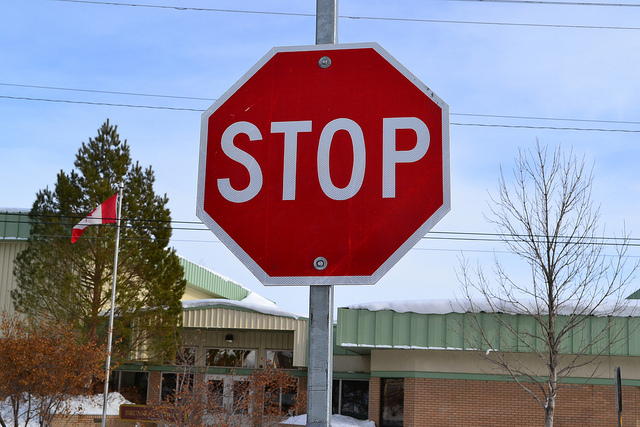“Failure to yield” acquittal sparks debate over stop signs
A picture might be worth a thousand words, but a sign is worth much, much more — especially when it’s a stop sign at an intersection. But is the role of stop signs up for interpretation? We wouldn’t have thought so. After all, their function seems pretty clear: STOP. And, yet, one minor traffic ticket and subsequent acquittal has sparked a debate over stop signs.
Corner Brook is a town in Newfoundland, Canada. A teenage resident of Corner Brook received a citation for failure to yield after he made a right turn without stopping. In a case of seriously bad timing, the wayward right turn nearly caused the teenager to collide with a police cruiser.

In Canada, a teen’s traffic ticket acquittal raised important questions about stop signs. From Ishmael daro.
Fortunately, no one was hurt. It seemed like an open and shut case. After all, who pulls into traffic in front of a police cruiser and gets away with it? But then the teenager and his father argued that the road signage at the intersection was misleading — and the argument worked. The teen was acquitted. If the comments section of the Western Star article on the case are at all representative of the community’s reaction to the acquittal, people are pretty astounded.
Here’s the thing: At the intersection in question, Sunnyslope Drive abuts Lewin Parkway. Drivers on Sunnyslope Drive have two lanes and three options at the intersection: 1) Use the left lane to turn left onto Lewin Drive; 2) Use the left lane to continue straight onto Sunnyslope Drive; or 3) Use the curving right lane to turn right onto Lewin Parkway. The stop sign is located in between the left lane and the curving right lane.
No one could argue that the young Corner Brook driver failed to see the stop sign. After all, it’s in the middle of the road, and not the least bit obscured from view. However, the driver — who only recently received his driver’s license —testified in court that he learned in his driver’s education class to “only halt when there was a stop sign to [his] right as he entered an intersection.”
This got us thinking. I can’t speak for Canada, but in America, one might expect there to be a second stop sign (or, more commonly, a “yield” sign) located to the right of the curving right lane.
Does the absence of a sign to the right of your lane mean you can pull into traffic any which way you please? Common sense and self-preservation say, “absolutely not.” However, at least according to Judge Catherine Alen-Westby, the lack of a sign to the right of the right lane was “confusing,” and the teen was simply doing what he was instructed to do. Therefore, she let him off the hook.
Western Star writer Gary Kean reports that there is little consistency between intersections on Lewin Drive. Some have stop signs in the middle of the lanes and to the right of the right lane. Others have one, but not the other.
As mentioned previously, the residents who commented on the article did not look favorably upon the teen’s decision-making skills. The tone was almost universally scornful over the acquittal. And, yet, when the Western Star posed a poll asking if the exit needs another stop sign, 66 percent of respondents said “yes.”
We hope, for the sake of the teen and his family, that the teen learns to apply common sense — or at least a willingness to look both ways — when there is any question about right of way at an intersection.
In the meantime, the city is “looking into” the intersection to see if signage needs to be revised.
